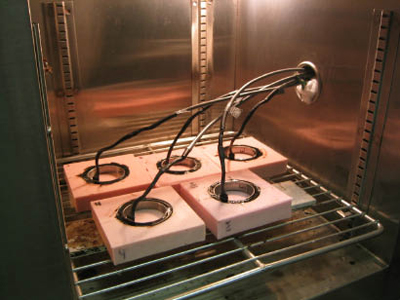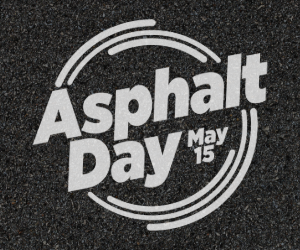 An interlaboratory study conducted with the help of a Federal Highway Administration (FHWA) Technology Partnership grant confirmed the accuracy and usability of a device to pinpoint the temperature at which asphalt binder will crack.
An interlaboratory study conducted with the help of a Federal Highway Administration (FHWA) Technology Partnership grant confirmed the accuracy and usability of a device to pinpoint the temperature at which asphalt binder will crack.
Cold temperatures can cause asphalt pavements to crack if the right type of asphalt binder isn’t used for the climate. That can lead to premature deterioration of a roadway and create the need for costly, congestion-causing repairs.
The Asphalt Binder Cracking Device, or ABCD, uses a simple, reliable method to determine the susceptibility of various binders to thermal cracking before they are used on paving projects. Highways for LIFE provided a grant under its Technology Partnership program to help EZ Asphalt Technology LLC of Athens, Ohio, develop and evaluate the ABCD. The first phase of testing involved conducting a field validation of the ABCD and refining the equipment and analysis software.
In the second phase, 31 laboratories participated in a study to evaluate the repeatability, accuracy and simplicity of the testing system. The volunteers included 18 state and federal government labs, one Superpave Center, one Canadian Ministry of Transportation lab, five universities, and six private facilities.
ABCD Lab Tests
Technicians at each lab set up the ABCD testing system and conducted a series of three test runs on three sets of asphalt binder specimens. Despite limited experience using the device, all of the participating labs were able to complete the tests successfully. Results of the tests showed that the standard deviation of the temperature was within an acceptable range of precision.
Ten labs also conducted a Bending Beam Rheometer test, a more traditional test for low-temperature properties, on the asphalt binder samples. The results indicated that the precision estimates of ABCD cracking temperature and BBR critical temperature were comparable.
Users provided feedback on their ABCD testing experience, which was used to further refine the test procedure. Several reported that trimming the poured asphalt sample was difficult, so the test procedure was simplified to eliminate that step without affecting the test’s accuracy.
“Most labs reported that ABCD was an easy test to run,” said Dr. Sang-Soo Kim, owner of EZ Asphalt and associate professor of civil engineering at Ohio University, who developed the device. “Engineers and technicians liked the fact that they could see the performance of the tested binder directly without additional analysis.”
Field-Like Conditions
Unlike conventional test methods, the ABCD creates thermal cracking conditions similar to those in the field. It consists of a metal ring equipped with temperature and strain gauges that fits into a silicone mold. Heated asphalt binder is poured around the ring and the device is cooled.
As the temperature falls, the asphalt binder contracts more than the metal ring, causing the binder to fracture. A computerized data acquisition system captures the temperature and stress level at which the fracture occurs. That information can be used to grade asphalt binders for expected climate conditions, as well as to develop new binders that can better withstand cold temperatures.
The American Association of State Highway and Transportation Officials has made the ABCD test procedure a provisional standard: TP92—Determining the Cracking Temperatures of Asphalt Binder Using the Asphalt Binder Cracking Device. It is the first step toward final adoption as a standard. AASHTO adopts provisional standards on a temporary basis so the highway community can have access to new technologies and procedures quickly, and it can convert a provisional standard to a full standard any time during the eight-year temporary period.
Meanwhile, EZ Asphalt plans to develop a range of ABCD models to satisfy industry’s different needs. “Thermal cracking is a significant and costly problem. Highways for LIFE helped transform ABCD from a research tool to a problem-solving tool that can be used in real life,” said Kim. “We plan to address the feedback of the participating labs, and we already have significantly refined the test equipment and procedures.”














